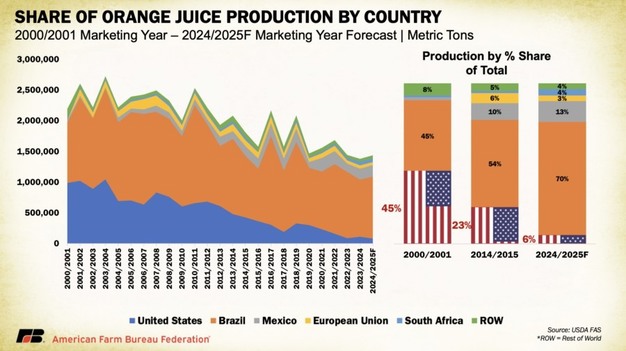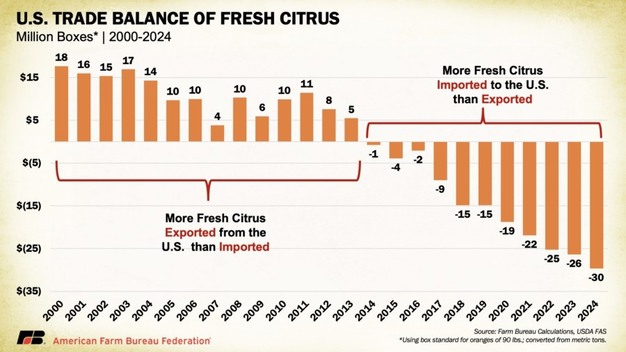The U.S. Food and Drug Administration (FDA) has proposed an update to the 60-year-old standard of identity for pasteurized orange juice, lowering the minimum sugar content requirement from 10.5° Brix to 10.0°. The proposed change aims to help U.S. citrus growers and processors adapt to declining sugar levels in domestic fruit without affecting taste or price for consumers.
 © American Farm Bureau Federation
© American Farm Bureau Federation
U.S. orange production has fallen sharply due to Huanglongbing (HLB, or citrus greening disease) and hurricanes. Florida's output has dropped by about 92% since 2005, from 150 million boxes to a projected 12 million in 2025. The 2024/25 crop is expected to be the smallest since 1930, 33% below last season. Florida's citrus industry supported more than 32,000 jobs and nearly US$7 billion in economic output in 2021, but shrinking production has reduced its economic role. California now supplies nearly 80% of U.S. oranges, up from 20–30% two decades ago, though national production remains historically low.
 © American Farm Bureau Federation
© American Farm Bureau Federation
One effect of HLB is lower Brix levels. In the 1960s, Florida oranges averaged 11.8° Brix, and the FDA's 1963 standard required 10.5°. By the 2022/23 season, the Florida average had dropped to about 9.7°, below the current legal minimum. To comply, processors often blend U.S. juice with higher-Brix imports from Brazil or Mexico, reducing the share of domestic fruit in the final product and increasing reliance on imports.
FDA's proposal would expand the range of juice that qualifies as pasteurized orange juice. Processors could use more U.S.-grown fruit without discarding low-Brix harvests or relying on imported concentrate. The agency estimates annual savings of more than US$50 million, or about US$0.39 per gallon, primarily from reduced blending costs. U.S. orange juice consumption in 2024/25 is forecast at around 128 million gallons.
 © American Farm Bureau Federation
© American Farm Bureau Federation
The U.S. share of world orange juice production has declined from 45% in 2000 to just 6% today. Imports have outpaced exports since 2014, with the 2025 trade deficit projected to exceed 30 million boxes. Domestic orange juice supplied nearly 75% of U.S. demand in 2005 but now meets only 16%. FDA's proposed change could help retain more domestic juice in the market and reduce diversion of fruit into lower-value outlets.
The public comment period for the FDA proposal runs until November 4. The agency has also requested input on further adjustments, including removing the Brix minimum entirely or raising the allowable mandarin/tangerine content in pasteurized orange juice from 10% to 15%.
 © American Farm Bureau FederationFor more information:
© American Farm Bureau FederationFor more information:
American Farm Bureau Federation
Tel: +1 202 406 3600
Email: [email protected]
www.fb.org
